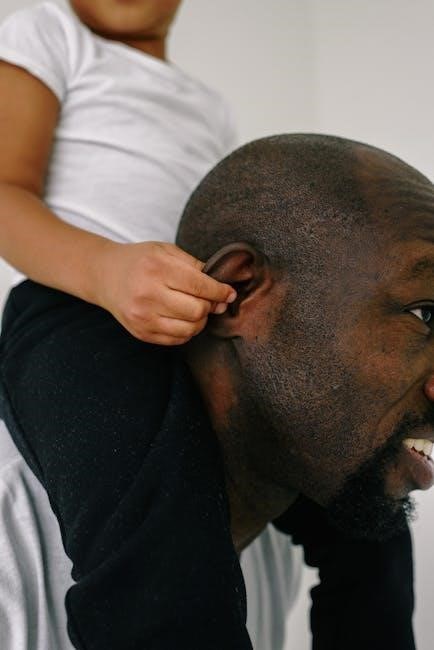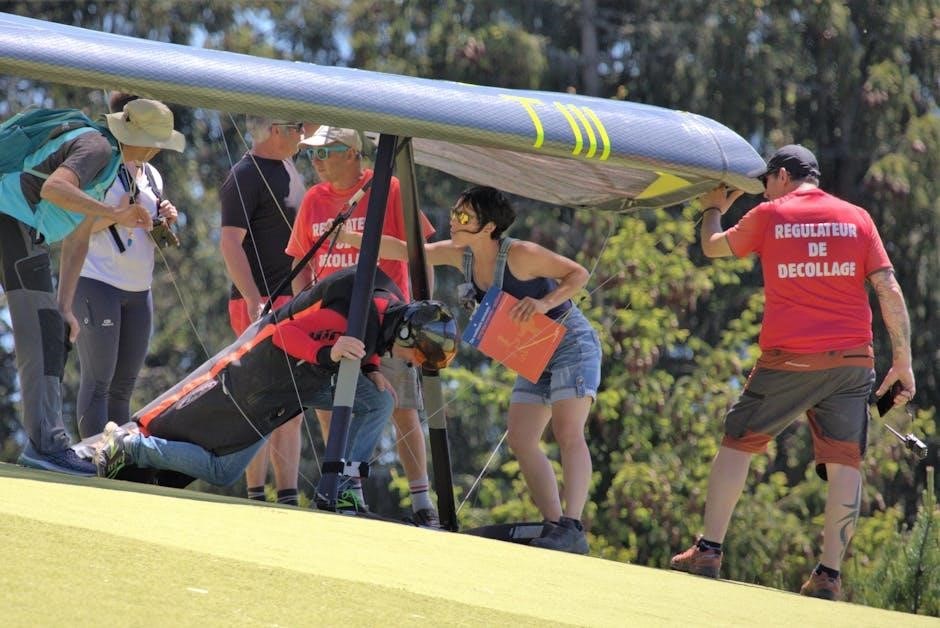Basic Life Support (BLS) is a critical set of skills aimed at saving lives during cardiac arrest and other emergencies. It combines CPR‚ AED use‚ and airway management to maintain circulation and breathing until advanced care arrives. BLS training is essential for healthcare providers‚ first responders‚ and anyone needing to respond to life-threatening situations effectively. This manual serves as a comprehensive guide for instructors to teach these lifesaving techniques‚ ensuring learners gain the knowledge and confidence to act decisively in emergencies.
Definition and Importance of BLS
Basic Life Support (BLS) is a set of critical skills used to sustain life during cardiac arrest and other emergencies. It includes CPR‚ AED use‚ and airway management to maintain circulation and breathing. BLS is essential for healthcare professionals and first responders‚ as it bridges the gap between the onset of cardiac arrest and advanced medical care. Its importance lies in preventing neurological damage and death by preserving vital organ function. Properly performed BLS significantly improves survival rates‚ making it a cornerstone of emergency medical training and practice. Its universal application ensures timely intervention in life-threatening situations.

Role of BLS in Cardiac Arrest Management
Basic Life Support (BLS) plays a pivotal role in cardiac arrest management by providing immediate interventions to restore blood circulation and breathing. BLS ensures the heart and brain receive oxygen until advanced care is available. It involves rapid assessment‚ CPR‚ AED use‚ and airway management‚ which are critical steps to preserve neurological function and prevent death. Timely BLS implementation significantly improves survival rates by maintaining perfusion to vital organs. It serves as the foundation for advanced life support (ALS) measures‚ emphasizing the importance of prompt action in the first few minutes of cardiac arrest.

Core BLS Skills
Core BLS skills include CPR‚ AED use‚ airway management‚ and relief of airway obstruction. These skills are essential for maintaining circulation and breathing in emergencies.
Cardiopulmonary Resuscitation (CPR)
Cardiopulmonary resuscitation (CPR) is a lifesaving technique that combines chest compressions with rescue breaths. It is performed when a person’s heart stops beating‚ maintaining blood circulation and oxygen supply to vital organs. Proper CPR involves a ratio of 30 chest compressions to two breaths for adults. Compression depth should be at least 2 inches‚ and breaths should last one second each. Immediate initiation of CPR doubles or triples survival chances. CPR should continue until emergency medical personnel arrive or a defibrillator is used. Training emphasizes minimizing interruptions and allowing full chest recoil between compressions to ensure effectiveness.
Use of Automated External Defibrillator (AED)
The Automated External Defibrillator (AED) is a portable device that restores a normal heart rhythm during sudden cardiac arrest. It analyzes the heart’s electrical activity and delivers an electric shock if a life-threatening arrhythmia is detected. Proper use involves turning the device on‚ attaching pads to the victim’s chest‚ and following voice prompts. The AED simplifies defibrillation by automating rhythm analysis and shock delivery. Instructors should emphasize checking the device’s readiness‚ placing pads correctly‚ and ensuring no one touches the victim during shock delivery. Regular AED maintenance is also crucial to ensure functionality in emergencies.
Airway Management
Airway management is a critical component of BLS‚ focusing on ensuring a patient’s airway is open and clear for adequate ventilation. Techniques include the head tilt-chin lift and jaw thrust maneuvers to prevent airway obstruction. Proper use of airway adjuncts‚ such as oropharyngeal and nasopharyngeal airways‚ can maintain patency in unconscious patients. Suction devices are used to remove debris like vomit or blood. Bag-valve-mask (BVM) ventilation is essential for patients who are not breathing or have inadequate breathing. Instructors must emphasize proper technique to avoid gastric inflation and ensure effective ventilation.

Relief of Airway Obstruction
Relieving airway obstruction is crucial for maintaining oxygenation and ventilation. For conscious adults‚ abdominal thrusts (Heimlich maneuver) are performed to dislodge the object. For infants and children‚ back slaps and chest thrusts are used. In unconscious patients‚ airway obstruction is managed during CPR with chest compressions. Instructors should teach proper techniques to avoid injury and ensure effectiveness. Recognizing signs like choking‚ inability to speak‚ and clutching the neck is vital. Immediate action is necessary to prevent complications like hypoxia or cardiac arrest. Proper training ensures rescuers can act confidently and effectively in such emergencies.

BLS Instructor Qualifications
A BLS instructor must hold a valid BLS certification‚ have a healthcare background‚ and complete an instructor course. They should demonstrate strong teaching and leadership skills.
Prerequisites for Becoming a BLS Instructor

To become a BLS instructor‚ individuals must be healthcare professionals with a valid BLS provider certification. They must complete an Instructor Essentials course and a BLS Instructor course‚ which includes both theoretical and practical training. Candidates must align with an approved AHA Training Center within 30 days of completing the course. Prior teaching or healthcare experience is highly recommended. Additionally‚ a background check may be required‚ depending on the employer or training center. Candidates must also demonstrate a strong understanding of BLS principles and the ability to effectively communicate and teach. Staying updated with the latest BLS guidelines is essential.
Training and Certification Process
The BLS instructor training involves completing an approved Instructor Essentials course‚ which covers teaching methodologies‚ course administration‚ and material usage. Candidates must then attend a hands-on training session‚ where they practice teaching and receive feedback. Practical training includes demonstrating BLS skills and leading mock training sessions. To certify‚ candidates must pass a written exam and a practical skills assessment. They must also align with an approved Training Center within 30 days of course completion. Certification is valid for two years‚ requiring renewal through continuing education and adherence to current BLS guidelines. Ongoing updates ensure instructors remain proficient in teaching lifesaving skills effectively.
Responsibilities of a BLS Instructor
A BLS instructor is responsible for teaching the BLS curriculum effectively‚ ensuring participants understand and apply skills correctly. They must deliver high-quality training‚ provide constructive feedback‚ and create an engaging learning environment. Instructors are also tasked with assessing student performance‚ issuing certifications‚ and maintaining training records. They must stay updated on BLS guidelines and adhere to certification standards. Additionally‚ instructors should promote the importance of BLS in real-world scenarios and encourage continuous learning. Their role is critical in preparing individuals to respond confidently during emergencies‚ ultimately contributing to saving lives and improving patient outcomes.

BLS Course Structure
The BLS course is structured to provide hands-on training‚ simulations‚ and interactive sessions‚ focusing on CPR‚ AED use‚ and airway management techniques.
Overview of the BLS Training Program
The BLS training program is designed to equip healthcare professionals with critical life-saving skills. It covers essential techniques for cardiopulmonary resuscitation (CPR)‚ automated external defibrillator (AED) use‚ and airway management. The program emphasizes hands-on practice‚ scenario-based simulations‚ and real-life application of BLS protocols. Participants learn to recognize cardiac arrest‚ perform high-quality chest compressions‚ and provide rescue breaths. The training also addresses relief of foreign body airway obstruction in adults‚ children‚ and infants. It is tailored for healthcare providers‚ including nurses‚ doctors‚ and emergency responders‚ ensuring they are prepared to act confidently in critical situations. The program aligns with updated BLS guidelines and includes both practical skills and written assessments to ensure competency.
Course Outline and Duration
The BLS training program typically lasts between 4 to 6 hours for initial certification and 2 to 3 hours for renewal. The course is structured into modules‚ covering core skills like CPR‚ AED use‚ and airway management. Participants engage in hands-on practice and scenario-based simulations. The program also includes lectures‚ videos‚ and group discussions to reinforce learning. Practical skills are assessed through demonstrations‚ and written exams may be required. The course duration ensures adequate time for both instruction and practice‚ preparing participants to confidently apply BLS techniques in real-life emergencies. The structured format ensures comprehensive understanding and retention of critical life-saving skills.
Assessment and Certification
Assessment in BLS training ensures participants demonstrate proficiency in critical skills. Practical exams focus on correct CPR technique‚ AED use‚ and airway management. Written tests evaluate knowledge of protocols and algorithms. Successful completion requires scoring at least 85% on both components. Upon passing‚ participants receive a certification card valid for two years. Certification reflects mastery of BLS skills and adherence to current guidelines. Renewal requires completing an update course‚ ensuring continued competence. The assessment process guarantees that instructors and participants are equipped to perform life-saving interventions effectively and confidently in emergencies.

Special Considerations in BLS
Special considerations in BLS involve adapting techniques for pediatric‚ infant‚ and special situations‚ ensuring culturally sensitive care and environmental adjustments to maximize patient outcomes effectively.
Pediatric and Infant BLS
Pediatric and infant BLS requires specialized techniques due to anatomical and physiological differences. For children‚ chest compressions are deeper (at least ⅓ of chest depth)‚ and ventilation rates are higher. Infants need a two-thumb-encircling hands technique for compressions. Automated external defibrillators (AEDs) are used similarly to adults but with pediatric pads when available. Airway management differs‚ with emphasis on maintaining a neutral head position for infants. Training focuses on recognizing cardiac arrest signs in younger patients and adapting skills to smaller bodies. These tailored approaches improve outcomes in pediatric and infant cardiac emergencies‚ emphasizing the need for specific BLS instruction.
BLS in Special Situations
BLS in special situations requires adaptability and knowledge of unique protocols. Trauma-related cardiac arrest may involve controlling bleeding alongside CPR. Drowning victims need immediate rescue breathing before chest compressions. Burns or severe injuries may necessitate altered hand placement for compressions. In confined spaces‚ alternative chest compression techniques‚ like the two-finger method‚ may be used. High-altitude or hypothermic cardiac arrests require prolonged resuscitation efforts. These scenarios demand tailored approaches while maintaining core BLS principles. Training emphasizes recognizing and responding to these unique challenges effectively‚ ensuring optimal outcomes in unconventional settings. Special situations testing is a critical component of BLS certification.

Teaching BLS Skills
Teaching BLS skills involves hands-on training‚ demonstrations‚ and feedback. Instructors create a structured‚ engaging environment‚ ensuring learners master CPR‚ AED use‚ and airway management through active participation and real-life simulations.
Effective Demonstration Techniques
Effective demonstration is crucial for teaching BLS skills. Instructors should use clear‚ deliberate movements to illustrate proper techniques‚ such as chest compressions and AED use. Breaking down complex skills into simple‚ observable steps ensures learners can replicate them accurately. Encouraging questions and interactive participation enhances understanding. Demonstrations should align with current guidelines and incorporate real-life scenarios to promote practical application. Instructors must maintain a calm‚ confident demeanor to build learner confidence. Immediate feedback during hands-on practice reinforces proper technique and addresses errors promptly. Regularly updating demonstrations to reflect the latest BLS protocols ensures training remains relevant and effective.
Hands-On Practice and Feedback
Hands-on practice is essential for mastering BLS skills‚ allowing learners to apply techniques in real-time. Instructors should provide immediate‚ constructive feedback to correct errors and reinforce proper methods. This interactive approach ensures learners gain confidence and proficiency. Feedback should focus on key aspects like chest compression depth‚ rate‚ and hand placement. Incorporating scenario-based training enhances practical application. Regular practice sessions and debriefings help learners refine their skills. Timely feedback improves retention and competency‚ ensuring learners are prepared to perform BLS effectively in emergencies. Continuous assessment during practice ensures adherence to guidelines and fosters a culture of excellence in BLS training.

Updates in BLS Guidelines
The American Heart Association regularly updates BLS guidelines to reflect the latest research‚ ensuring evidence-based practices. Recent changes include updated chest compression depths and AED usage protocols.
Latest Changes in BLS Protocols
The American Heart Association (AHA) has introduced updates to BLS protocols‚ focusing on improving outcomes in cardiac arrest scenarios. Key changes include revised chest compression depth (at least 2 inches in adults) and compression rates (100-120 BPM). Emphasis has been placed on minimizing interruptions during CPR and ensuring high-quality compressions. Updated guidelines also address the use of automated external defibrillators (AEDs)‚ including earlier deployment and rhythm analysis. Pediatric BLS protocols now include specific adjustments for infants and children‚ such as compression depth proportional to body size. Additionally‚ choking relief techniques have been refined for infants. Instructors must stay updated to reflect these changes in training.
Importance of Staying Updated
Staying updated in BLS guidelines is critical for instructors to provide evidence-based training. Medical research and protocols evolve‚ and outdated methods can lead to ineffective care. Instructors who remain current ensure students learn the most effective techniques‚ improving patient outcomes. Updated knowledge also enhances instructor credibility and confidence. Furthermore‚ staying informed about new tools and technologies‚ such as advanced AEDs or feedback devices‚ prepares instructors to integrate these into training. Regular updates ensure alignment with industry standards‚ maintaining the quality and relevance of BLS education. Continuous learning is essential for instructors to uphold their role as trusted healthcare educators.
BLS training empowers individuals with effective and lifesaving skills‚ fostering preparedness and confidence in emergencies. By mastering these techniques‚ instructors inspire others to save lives‚ creating a safer community.
The Impact of BLS Training
BLS training significantly enhances community resilience by equipping individuals with life-saving skills. It boosts survival rates during cardiac emergencies and fosters a culture of preparedness. Trained participants can act confidently‚ reducing mortality and improving outcomes. The widespread adoption of BLS training creates a network of responders ready to intervene effectively. This empowerment not only saves lives but also strengthens societal safety. High-quality instruction ensures that trainees are proficient and prepared‚ making BLS training a cornerstone of public health and safety. Its impact extends beyond individuals‚ benefiting communities and fostering a chain reaction of life-saving actions.
Final Thoughts on BLS Instruction
Effective BLS instruction is vital for empowering individuals to act decisively in emergencies. Instructors must emphasize quality‚ precision‚ and real-world application to ensure learners grasp critical skills. A passionate and knowledgeable instructor inspires confidence and competence‚ fostering a culture of preparedness. Continuous updates in guidelines and techniques are essential for maintaining relevancy. By prioritizing hands-on practice and scenario-based learning‚ instructors create a lasting impact. Ultimately‚ the goal is to equip learners with the ability to save lives‚ making BLS training a cornerstone of community safety and emergency preparedness. The ripple effect of skilled instruction extends far beyond the classroom.
